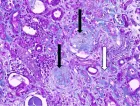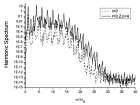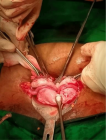Abstract
Research Article
The Impact of a Single Apheretic Procedure on Endothelial Function Assessed by Peripheral Arterial Tonometry and Endothelial Progenitor Cells
Gabriele Cioni*, Francesca Cesari, Rossella Marcucci, Anna Maria Gori, Lucia Mannini, Agatina Alessandrello Liotta, Elena Sticchi, Ilaria Romagnuolo, Rosanna Abbate and Giovanna D’Alessandri
Published: 22 February, 2017 | Volume 1 - Issue 1 | Pages: 001-007
Introduction: Endothelial progenitor cells (EPC) are involved in vascular repair and proliferation, contributing to the long-term outcomes of apheretic treatment. Aim of this study was to investigate the relationships between endothelial function, assessed by levels of bone marrow-derived progenitor cells and endothelial response to hyperaemia, and clinical and biohumoral parameters in high vascular risk patients before, immediately after, 24-hours and 72 hours after a single lipid apheresis procedure.
Material and Methods: We evaluated lipid profile, endothelial function and endothelial progenitor cells before (T0), immediately after (T1), 24h after (T2) and 72h after (T3) a lipoprotein apheresis procedure, in 8 consecutive patients [Sex: 62.5% M; Age; 63.29(12), mean, (range) years] with a personal history of acute coronary syndrome, symptomatic peripheral arterial disease and elevated plasma levels of lipoprotein (a) [Lp(a)]. Patients were on regularly weekly or biweekly lipoprotein apheresis, and they were treated with the FDA-approved Heparin-induced Extracorporeal LDL Precipitation (H.E.L.P.) (Plasmat Futura, B.Braun, Melsungen, Germany) technique. PAT values were expressed as the natural logarithm (Ln-RHI, normal values≥0.4) of the reactive hyperaemia index (RHI), which is the parameter automatically calculated by the device.
Results: We found a reduction in the natural logarithm of reactive hyperaemia index (Ln-RHI), assessed immediately after the procedure (0.57±0.21 vs 0.72± 0.29); difference between T2 and T0 was statistically significant (0.43±0.24 vs 0.72±0.29; p=0.006). Reduction in Ln-RHI values was documented in all patients, two subjects showing a Ln-RHI<0.4 at T1, and four at T2. At T3, PAT values were increased significantly (0.91±0.18) in comparison to T1 and T2, showing a median value higher than at T0. Cd34+/Kdr+ and Cd133+/Kdr+ showed a minimum increase in median values at T1, and a higher increase at T2, in comparison to baseline. Differences in Cd34+/133+/Kdr+ values at different times were not statistically significant. A significant reduction in circulating endothelial cells (CEC) count at T2 in comparison to T0 was found (12.00±8.85 vs 23.86±12.39; p=0.024).
Discussion: At 24h and 72h after procedures, we found an improvement in endothelial function, expressed by an increase in PAT values and EPC levels, and by a reduction in CEC.
Read Full Article HTML DOI: 10.29328/journal.hjvsm.1001001 Cite this Article Read Full Article PDF
References
- Abbate R, Cioni G, Ricci I, Miranda M, Gori AM. Thrombosis and acute coronary syndrome. Thromb Res. 2012; 129: 235-240. Ref.: https://goo.gl/NRJX4t
- Klingel R, Heibges A, Fassbender C. Lipoprotein apheresis results in plaque stabilization and prevention of cardiovascular events: comments on the prospective Pro(a)LiFe study. Clin Res Cardiol Suppl. 2015; 10: 46-50. Ref.: https://goo.gl/0nA3Qx
- Koziolek MJ, Hennig U, Bramlage C, Grupp C, Zapf A, et al. Retrospective analysis of long-term LDL-apheresis in a single centre. Ther Apher Dial. 2010; 14: 143-152. Ref.: https://goo.gl/t2USVF
- Ramunni A, Petrarulo F, Grasso C, Papagni S, Brescia P. Acute and chronic effects of therapeutic apheresis. Atheroscler Suppl. 2013; 14: 83-87. Ref.: https://goo.gl/9Vys03
- Tamai O, Matsuoka H, Itabe H, Wada Y, Kohno K, Imaizumi T. Single LDL apheresis improves endothelium-dependent vasodilatation in hypercholesterolemic humans. Circulation. 1997; 95: 76-82. Ref.: https://goo.gl/fBNtqo
- Igarashi K, Tsuji M, Nishimura M, Horimoto M. Improvement of endothelium-dependent coronary vasodilation after a single LDL apheresis in patients with hypercholesterolemia. J Clin Apher. 2004; 19: 11-16. Ref.: https://goo.gl/w726k7
- Strauchmann J, Wallbach M, Bramlage C, Puls M, Konstantinides S, et al. Lipoprotein apheresis reduces biomarkers of plaque destabilization and cardiovascular risk. J Clin Apher. 2014; 29: 235-242. Ref.: https://goo.gl/kPtnrK
- Patschan D, Patschan S, Henze E, Wessels JT, Koziolek M, et al. LDL lipid apheresis rapidly increases peripheral endothelial progenitor cell competence. J Clin Apher. 2009; 24: 180-185. Ref.: https://goo.gl/3Zrzid
- Ramunni A, Brescia P, Dambra P, Capuzzimati L, Ria R, et al. Effect of low-density lipoprotein apheresis on circulating endothelial progenitor cells in familial hypercholesterolemia. Blood Purif. 2010; 29: 383-389. Ref.: https://goo.gl/WybIsJ
- Schwartz J, Winters JL, Padmanabhan A, Balogun RA, Delaney M, et al. Guidelines on the use of therapeutic apheresis in clinical practice-evidence-based approach from the Writing Committee of the American Society for Apheresis: the sixth special issue. J Clin Apher. 2013; 28: 145-284. Ref.: https://goo.gl/3wZ3dt
- Schnall RP, Shlitner A, Sheffy J, Kedar R, Lavie P. Periodic, Profound Peripheral Vasoconstriction – A New Marker of obstructive Sleep Apnea. SLEEP. 1999; 22: 939-946. Ref.: https://goo.gl/MbmEiC
- Kuvin JT, Patel AR, Sliney KA, Pandian NG, Sheffy J, et al. Assessment of Peripheral Vascular Endothelial Function with Finger Arterial Pulse Wave Amplitude. AHJ. 2003; 146: 168-174. Ref.: https://goo.gl/gykB9P
- Kuvin JT, Mammen A, Mooney P, Alsheikh-Ali AA, Karas RH. Assessment of Peripheral Vascular Endothelial Function in the Ambulatory Setting. Vascular Medicine. 2007; 12: 13-16. Ref.: https://goo.gl/wpDZCc
- Faizi AK, Kornmo DW, Agewall S. Evaluation of endothelial function using finger plethysmography. Clin Physiol Funct Imaging. 2009; 29: 372-375. Ref.: https://goo.gl/w8tc98
- Dhindsa M, Sommerlad SM, DeVan AE, Barnes JN, Sugawara J, et al. Interrelationships among non invasive measures of post ischemic macro- and microvascular reactivity. J Appl Physiol. 2008; 105: 427-432. Ref.: https://goo.gl/hXgbzG
- Cioni G, Berni A, Gensini GF, Abbate R, Boddi M. Impaired Femoral Vascular Compliance and Endothelial Dysfunction in 30 Healthy Male Soccer Players: Competitive Sports and Local Detrimental Effects. Sports Health. 2015; 7: 335-340. Ref.: https://goo.gl/2aDio0
- Fatini C, Sticchi E, Cesari F, Gori AM, Cioni G, et al. Relationship among endothelial response to hyperemia, bone marrow-derived progenitor cells, and parathyroid hormone in renal transplantation. Transplantation. 2012; 93: 835-841. Ref.: https://goo.gl/purHN0
- Cesari F, Nencini P, Nesi M, Caporale R, Giusti B,et al. Bone marrow-derived progenitor cells in the early phase of ischemic stroke: Relation with stroke severity and discharge outcome. J Cereb Blood Flow Metab. 2009; 29: 1983-1990. Ref.: https://goo.gl/nuifUh
- Cioni G, Boddi M, Fatini C, Romagnuolo I, Casini A, et al. Peripheral-arterial tonometry for assessing endothelial function in relation to dietary habits. Investig Med. 2013; 61: 867-871. Ref.: https://goo.gl/ivWgt
- Lu Q, Eriksson M, Jogestrand T, henriksson P, Freyschuss A. Micro- and macrocirculatory effects of apheresis in patients with familial hyperlipidemia. Ther Apher Dial. 2003; 7: 115-118. Ref.: https://goo.gl/LIhArB
- Mellwig KP, Pulawski E, Horstkotte D, van Buuren F. Lipid apheresis: oxidative stress, rheology, and vasodilatation. Clin Res Cardiol Suppl. 2012; 7: 45-49. Ref.: https://goo.gl/ENvLcQ
- Mellwig KP, van Buuren F, Schmidt HK, Wielepp P, Burchrt W, et al. Improved coronary vasodilatatory capacity by H.E.L.P. apheresis: comparing initial and chronic treatment. Ther Apher Dial. 2006; 10: 510-517. Ref.: https://goo.gl/azoLZL
- Steven S, Münzel T, Daiber A. Exploiting the Pleiotropic Antioxidant Effects of Established Drugs in Cardiovascular Disease. Int J Mol Sci. 2015; 16: 18185-223. Ref.: https://goo.gl/vz6pbm
Figures:
Similar Articles
-
The Impact of a Single Apheretic Procedure on Endothelial Function Assessed by Peripheral Arterial Tonometry and Endothelial Progenitor CellsGabriele Cioni*,Francesca Cesari,Rossella Marcucci,Anna Maria Gori,Lucia Mannini,Agatina Alessandrello Liotta,Elena Sticchi,Ilaria Romagnuolo,Rosanna Abbate,Giovanna D’Alessandri. The Impact of a Single Apheretic Procedure on Endothelial Function Assessed by Peripheral Arterial Tonometry and Endothelial Progenitor Cells. . 2017 doi: 10.29328/journal.hjvsm.1001001; 1: 001-007
-
Hepato-Pulmonary syndrome and Porto-Pulmonary Hypertension: Rare combination cause of Hypoxemia in patient with end-stage renal failure on Hemodialysis and hepatitis C Induced Decompensated CirrhosisAwad Magbri*,Mariam El-Magbri,Eussera El-Magbri. Hepato-Pulmonary syndrome and Porto-Pulmonary Hypertension: Rare combination cause of Hypoxemia in patient with end-stage renal failure on Hemodialysis and hepatitis C Induced Decompensated Cirrhosis. . 2017 doi: 10.29328/journal.avm.1001002; 1: 008-012
-
Management of Popliteal Artery aneurysms: Experience in our centerMichiels Thirsa,Vleeschauwer De Philippe*. Management of Popliteal Artery aneurysms: Experience in our center. . 2018 doi: 10.29328/journal.avm.1001003; 2: 001-009
-
Cystic adventitial disease of the external iliac artery with disabling claudication: A case report and short reviewNalaka Gunawansa*. Cystic adventitial disease of the external iliac artery with disabling claudication: A case report and short review. . 2018 doi: 10.29328/journal.avm.1001004; 2: 010-013
-
Anesthetic considerations for endovascular repair of ruptured abdominal aortic aneurysmsKH Kevin Luk*,Koichiro Nandate. Anesthetic considerations for endovascular repair of ruptured abdominal aortic aneurysms. . 2018 doi: 10.29328/journal.avm.1001005; 2: 014-019
-
Severe aorto-iliac occlusive disease: Options beyond standard aorto-bifemoral bypassKonstantinos Filis*,Constantinos Zarmakoupis,Fragiska Sigala,George Galyfos . Severe aorto-iliac occlusive disease: Options beyond standard aorto-bifemoral bypass. . 2018 doi: 10.29328/journal.avm.1001006; 2: 020-024
-
Navigation in the land of ScarcityAwad Magbri*,Mariam El-Magbri. Navigation in the land of Scarcity. . 2018 doi: 10.29328/journal.avm.1001007; 2: 025-026
-
Transcatheter embolization of congenital vascular malformations, single center experienceMohammed Habib*,Majed Alshounat. Transcatheter embolization of congenital vascular malformations, single center experience. . 2019 doi: 10.29328/journal.avm.1001008; 3: 001-006
-
A fatal portal vein thrombosis: A case reportM Kechida*,W Ben Yahia,W Mnari. A fatal portal vein thrombosis: A case report. . 2019 doi: 10.29328/journal.avm.1001009; 3: 007-008
-
PR and QT intervals short on the same electrocardiogramFrancisco R Breijo-Márquez*. PR and QT intervals short on the same electrocardiogram. . 2020 doi: 10.29328/journal.avm.1001010; 4: 001-004
Recently Viewed
-
Intravenous Leiomyomatosis of the Uterus with Intracardiac ExtensionTomas Reyes-del Castillo*,Minerva I Hernandez-Rejon,Jose L Ruiz-Pier,Mario Peñaloza-Guadarrama,Carlos E Merinos-Avila,Cristina Juarez-Cabrera,Pedro A del Valle-Maldonado,Sofia Ley-Tapia,Valentín Gonzalez-Flores. Intravenous Leiomyomatosis of the Uterus with Intracardiac Extension. Arch Vas Med. 2025: doi: 10.29328/journal.avm.1001021; 9: 003-007
-
Hepato-Pulmonary syndrome and Porto-Pulmonary Hypertension: Rare combination cause of Hypoxemia in patient with end-stage renal failure on Hemodialysis and hepatitis C Induced Decompensated CirrhosisAwad Magbri*,Mariam El-Magbri,Eussera El-Magbri. Hepato-Pulmonary syndrome and Porto-Pulmonary Hypertension: Rare combination cause of Hypoxemia in patient with end-stage renal failure on Hemodialysis and hepatitis C Induced Decompensated Cirrhosis. Arch Vas Med. 2017: doi: 10.29328/journal.avm.1001002; 1: 008-012
-
Deep Learning-Powered Genetic Insights for Elite Swimming Performance: Integrating DNA Markers, Physiological Biometrics and Performance AnalyticsRahul Kathuria,Reeta Devi,Asadi Srinivasulu*. Deep Learning-Powered Genetic Insights for Elite Swimming Performance: Integrating DNA Markers, Physiological Biometrics and Performance Analytics. Int J Bone Marrow Res. 2025: doi: 10.29328/journal.ijbmr.1001020; 8: 006-015
-
Pure Erythroid Leukemia: The Sole Acute Erythroid LeukemiaFauzia Shafi Khan*,Khalid Mahmood,Alia Ahmad. Pure Erythroid Leukemia: The Sole Acute Erythroid Leukemia. Int J Bone Marrow Res. 2017: doi: 10.29328/journal.ijbmr.1001001; 1: 001-005
-
Causal Link between Human Blood Metabolites and Asthma: An Investigation Using Mendelian RandomizationYong-Qing Zhu, Xiao-Yan Meng, Jing-Hua Yang*. Causal Link between Human Blood Metabolites and Asthma: An Investigation Using Mendelian Randomization. Arch Asthma Allergy Immunol. 2023: doi: 10.29328/journal.aaai.1001032; 7: 012-022
Most Viewed
-
Impact of Latex Sensitization on Asthma and Rhinitis Progression: A Study at Abidjan-Cocody University Hospital - Côte d’Ivoire (Progression of Asthma and Rhinitis related to Latex Sensitization)Dasse Sery Romuald*, KL Siransy, N Koffi, RO Yeboah, EK Nguessan, HA Adou, VP Goran-Kouacou, AU Assi, JY Seri, S Moussa, D Oura, CL Memel, H Koya, E Atoukoula. Impact of Latex Sensitization on Asthma and Rhinitis Progression: A Study at Abidjan-Cocody University Hospital - Côte d’Ivoire (Progression of Asthma and Rhinitis related to Latex Sensitization). Arch Asthma Allergy Immunol. 2024 doi: 10.29328/journal.aaai.1001035; 8: 007-012
-
Causal Link between Human Blood Metabolites and Asthma: An Investigation Using Mendelian RandomizationYong-Qing Zhu, Xiao-Yan Meng, Jing-Hua Yang*. Causal Link between Human Blood Metabolites and Asthma: An Investigation Using Mendelian Randomization. Arch Asthma Allergy Immunol. 2023 doi: 10.29328/journal.aaai.1001032; 7: 012-022
-
An algorithm to safely manage oral food challenge in an office-based setting for children with multiple food allergiesNathalie Cottel,Aïcha Dieme,Véronique Orcel,Yannick Chantran,Mélisande Bourgoin-Heck,Jocelyne Just. An algorithm to safely manage oral food challenge in an office-based setting for children with multiple food allergies. Arch Asthma Allergy Immunol. 2021 doi: 10.29328/journal.aaai.1001027; 5: 030-037
-
Snow white: an allergic girl?Oreste Vittore Brenna*. Snow white: an allergic girl?. Arch Asthma Allergy Immunol. 2022 doi: 10.29328/journal.aaai.1001029; 6: 001-002
-
Cytokine intoxication as a model of cell apoptosis and predict of schizophrenia - like affective disordersElena Viktorovna Drozdova*. Cytokine intoxication as a model of cell apoptosis and predict of schizophrenia - like affective disorders. Arch Asthma Allergy Immunol. 2021 doi: 10.29328/journal.aaai.1001028; 5: 038-040

If you are already a member of our network and need to keep track of any developments regarding a question you have already submitted, click "take me to my Query."















































































































































